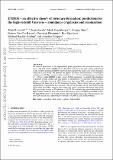| dc.contributor.author | Lovell, Mark R | |
| dc.contributor.author | Zavala, Jesús | |
| dc.contributor.author | Vogelsberger, Mark | |
| dc.contributor.author | Vogelsberger, Mark | |
| dc.contributor.author | Shen, Xuejian | |
| dc.contributor.author | Cyr-Racine, Francis-Yan | |
| dc.contributor.author | Pfrommer, Christoph | |
| dc.contributor.author | Sigurdson, Kris | |
| dc.contributor.author | Boylan-Kolchin, Michael | |
| dc.contributor.author | Pillepich, Annalisa | |
| dc.date.accessioned | 2022-07-18T18:07:28Z | |
| dc.date.available | 2021-09-20T18:22:51Z | |
| dc.date.available | 2022-07-18T18:07:28Z | |
| dc.date.issued | 2018 | |
| dc.identifier.uri | https://hdl.handle.net/1721.1/132527.2 | |
| dc.description.abstract | © 2018 The Author(s) Published by Oxford University Press on behalf of the Royal Astronomical Society. We contrast predictions for the high-redshift galaxy population and reionization history between cold dark matter (CDM) and an alternative self-interacting dark matter model based on the recently developed ETHOS framework that alleviates the small-scale CDM challenges within the Local Group.We perform the highest resolution hydrodynamical cosmological simulations (a 36 Mpc3 volume with gas cell mass of ~105M⊙ and minimum gas softening of ~180 pc) within ETHOS to date - plus a CDM counterpart - to quantify the abundance of galaxies at high redshift and their impact on reionization. We find that ETHOS predicts galaxies with higher ultraviolet (UV) luminosities than their CDM counterparts and a faster build-up of the faint end of the UV luminosity function. These effects, however, make the optical depth to reionization less sensitive to the power spectrum cut-off: the ETHOS model differs from the CDM τ value by only 10 per cent and is consistent with Planck limits if the effective escape fraction of UV photons is 0.1-0.5. We conclude that current observations of high-redshift luminosity functions cannot differentiate between ETHOS and CDM models, but deep James Webb Space Telescope surveys of strongly lensed, inherently faint galaxies have the potential to test non-CDM models that offer attractive solutions to CDM's Local Group problems. | en_US |
| dc.language.iso | en | |
| dc.publisher | Oxford University Press (OUP) | en_US |
| dc.relation.isversionof | 10.1093/MNRAS/STY818 | en_US |
| dc.rights | Creative Commons Attribution-Noncommercial-Share Alike | en_US |
| dc.rights.uri | http://creativecommons.org/licenses/by-nc-sa/4.0/ | en_US |
| dc.source | arXiv | en_US |
| dc.title | ETHOS – an effective theory of structure formation: predictions for the high-redshift Universe – abundance of galaxies and reionization | en_US |
| dc.type | Article | en_US |
| dc.contributor.department | Massachusetts Institute of Technology. Department of Physics | en_US |
| dc.contributor.department | MIT Kavli Institute for Astrophysics and Space Research | en_US |
| dc.relation.journal | Monthly Notices of the Royal Astronomical Society | en_US |
| dc.eprint.version | Author's final manuscript | en_US |
| dc.type.uri | http://purl.org/eprint/type/JournalArticle | en_US |
| eprint.status | http://purl.org/eprint/status/PeerReviewed | en_US |
| dc.date.updated | 2020-11-12T14:48:31Z | |
| dspace.orderedauthors | Lovell, MR; Zavala, J; Vogelsberger, M; Shen, X; Cyr-Racine, F-Y; Pfrommer, C; Sigurdson, K; Boylan-Kolchin, M; Pillepich, A | en_US |
| dspace.date.submission | 2020-11-12T14:48:38Z | |
| mit.journal.volume | 477 | en_US |
| mit.journal.issue | 3 | en_US |
| mit.license | OPEN_ACCESS_POLICY | |
| mit.metadata.status | Publication Information Needed | en_US |
